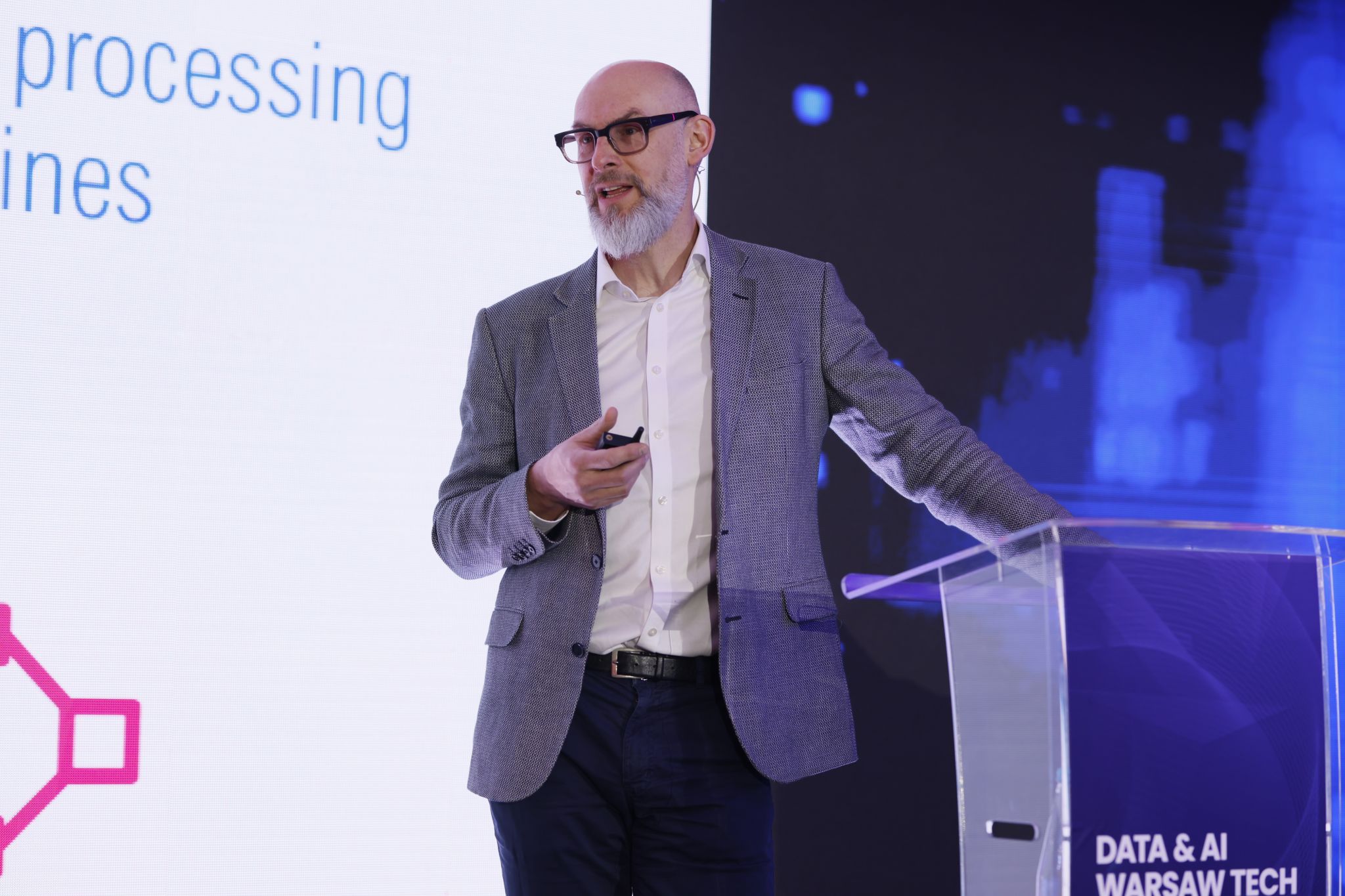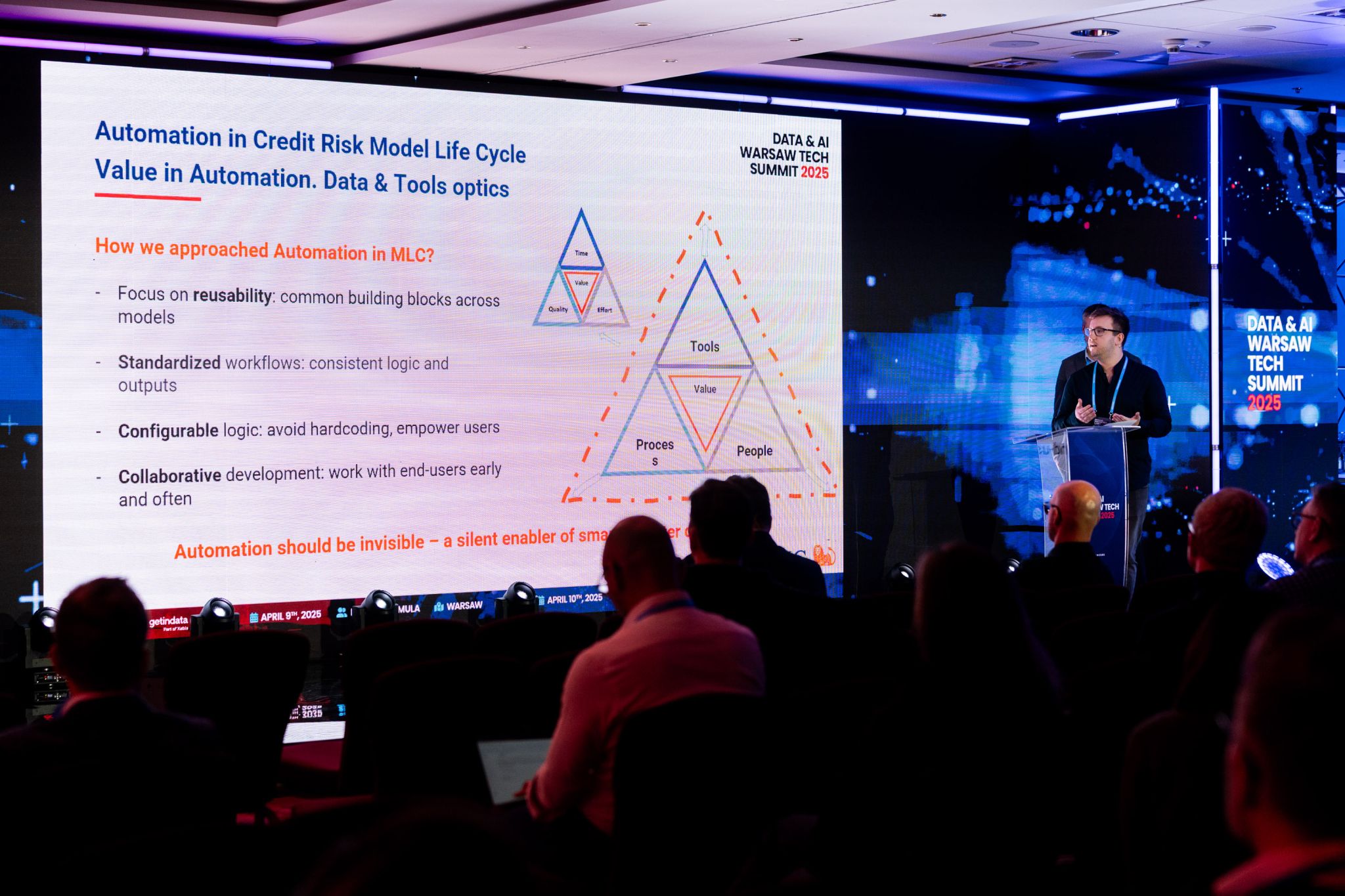From Data Governance to GenAI: Strategic Insights from Warsaw Tech Summit 2025

By Sabri Skhiri, CTO at Euranova
The Data & AI Warsaw Tech Summit — formerly known as the Big Data Technology Summit — reflects the growing convergence of data and AI. With over a decade of evolution behind it, it stands as a major reference in Central Europe. I attended the event to extract key trends that matter for our partners leading data and AI initiatives.
This article summarises the top strategic and technical takeaways — from data governance and GenAI, to scalable architectures and AI sovereignty — with a focus on what they mean for decision-makers in AI and data divisions. A deeper dive is available on our research site for those who want full technical coverage.
Key Trends and Topics
This is not always the case, but this conference was precisely in my exact area of expertise. The Data & AI Warsaw Tech Summit 2025 provided a comprehensive exploration of current trends and innovations in data and AI. We got the opportunity to interact with industry leaders like the founder of Restate and co-creator of Apache Flink. Attendees could engage in insightful discussions with professionals from various fields, including content moderation professionals at LinkedIn, the Head of data platform at Bolt, and tech leaders at TUI and Booking.com. And if I had to sum up the key trends that emerged from these discussions, they would be:
- Data Governance is Front and Centre: This was emphasised as a critical focus, with numerous talks and a strong presence of vendors in the exhibition hall, like Dataedo.
- Generative AI (GenAI) Expanding its Role: Speakers explored its disruptive impact on data science, enterprise landscapes, and the roles of computer scientists, including automation of tasks like testing at Ericsson and booking processes at TUI.
- High-Performance Data Architecture in Action: We addressed the need for robust architectures capable of handling real-time data efficiently. There also were detailed discussions on data mesh and platforms such as Azure Fabric, Snowflake, Databricks, and DBT.
- Growing Skill Development: Several talks highlighted the importance of advancing skills to keep pace with evolving technologies, illustrated by a case study on agent selection using SVMs with input features from models like Claude Sonnet 3. achieving a poor 75% of accuracy.
Keynote Highlights
AI Fabric: Advanced Context Engineering for Smarter AI Solutions - AB Initio
Jonathan Sunderland, Strategic Consultant at Ab Initio, discussed the components of traditional enterprise architecture and the transformative opportunities introduced by AI and agentic architectures. He also highlighted challenges posed by Large Language Models (LLMs), such as non-deterministic outputs and accountability issues, using the “Will Smith” analogy to explain that an action can destroy an entire career. Again, should you wish to dive deeper into those insights, check out our detailed blog post.
My personal thoughts are that addressing these challenges requires a comprehensive methodology encompassing modelling agentic architectures, implementing control points in the generative process, and establishing a comprehensive practice framework.
Another detail that truly resonated with me was the talk's ability to make us reconsider AI's influence on the enterprise landscape. We are actually covering this very same topic in one of our innovation tracks, to define the new service offering in this segment.
The Key Takeaway? Build comprehensive, auditable methodologies that embed AI responsibly into enterprise data practices.

HPE Innovation: AI Accelerating a Country – Defining Sovereignty in a New Era of AI
Veta Lohovska, Chief Technologist and Principal Data Scientist at HPE, discussed “Sovereign AI,” defined as a nation’s ability to independently develop, deploy, and manage AI technologies. This concept has gained prominence in the current geopolitical climate, where technological autonomy is increasingly linked to national security, economic competitiveness, and cultural preservation.
Lohovska highlighted three critical components: infrastructure (such as high-performance computing systems like the LUMI supercomputer in Finland), talent (skilled workforce development), and ecosystem (collaboration between academia, industry, and government). The LUMI AI Factory, providing startups and SMEs with access to advanced AI resources, was presented as a prime example of supporting Sovereign AI.
The Key Takeaway? Sovereign AI Is Not Just a Political Topic — It Has Operational Consequences. Data managers are increasingly responsible for ensuring that data pipelines, AI models, and infrastructure choices comply with local regulatory, ethical, and security standards.

Favourite Talks
Metrics Governance at Allegro
The talk was a blueprint for scalable, governed metrics orchestration integrating documentation-as-code, Infrastructure-as-Code, and Airflow. Marcin Cinciała and Karolina Zinner, Senior Data Engineers at Allegro, presented a unified framework for metrics management, that ensures consistency, reduces redundancy, and improves data quality. This is an excellent example of freedom in a box, invented by Toyota, providing just enough structure (schemas, templates, roles) so teams can innovate without compromising on control or quality. It directly contributes to data and AI governance, by exposing a clear and documented technical lineage of data.
The Key Takeaway? Metric Sprawl Is Real — and this is a data governance challenge in disguise: without consistent lineage and documentation, KPIs lose their trustworthiness. Data managers can adopt this metrics management framework to strengthen technical lineage, save time, and improve data quality — without introducing bottlenecks.
Automation in credit risk model life cycle at ING
In the evolving regulatory landscape, financial institutions face increasing pressure to maintain robust credit risk models that comply with stringent standards. Marcin Jeżo and Damian Kowalik discussed the role of automation in enhancing efficiency and compliance within the credit risk model lifecycle.
They highlighted the importance of standardisation before automation. Key technologies used included SAS for modelling logic, cloud platforms for scalability, and Large Language Models (LLMs) for regulatory understanding and monitoring. What I really liked in this talk is the standardisation effect of the automation. As SAP recommended, don’t just automate current workflows — redesign them for clarity, efficiency, and compliance first.
The Key Takeaway? We see that standardisation is absolutely necessary before automating anything. That is a very relevant learning. The sequence of standardise → automate → extend is a strong pattern for any governance framework.

Graph-Based Fraud Detection at Booking.com
Booking.com is exposed to a wide range of fraudulent activities, and Deepak Patankar and Mathijs de Jong discussed how they use graph technology for fraud detection. Indeed, fraud is rarely isolated. It's relational. Nodes represent entities, and edges depict relationships. This structure allows for the visualization and analysis of complex relationships that might indicate fraudulent behaviour. Their detection strategy combines graph analysis, machine learning models, and rule-based systems, and has led to a 33% reduction in fraud costs, while boosting dispute resolution with graph-based evidence.
As someone who's advocated for graph technology since 2011, it's thrilling to see its large-scale adoption in critical business domains. I can give examples in pharma, telecom, banking. Booking’s team also shared they were starting working on Graph Neural Networks (GNNs) to improve their results, and I took the opportunity to suggest they explore our INGENIOUS paper — built around explainable graph embeddings. This explainability layer is crucial not just for accuracy, but for trust — especially in regulated environments.
The Key Takeaway? Booking.com’s approach is a benchmark in operationalising graph analytics, blending real-time inference, scalable infra, and hybrid AI. But it also hints at the next wave: explainable, generative, graph-native AI.
Conclusion
As data and AI continue to converge, leaders must adapt architectures, invest in governance, and prepare their teams for a rapidly changing ecosystem. The Data & AI Warsaw Tech Summit 2025 encouraged participants to consider its broader context and implications, fostering a deeper understanding of the high-velocity advancements in the field. The discussions and presentations reinforced the importance of staying ahead of technological advancements and fostering collaboration within the industry.
Whether you're architecting a new data platform, evaluating GenAI use cases, or reviewing your team’s skill development plans, we're passionate about helping businesses navigate those paths. Do not hesitate to reach out to exchange further!